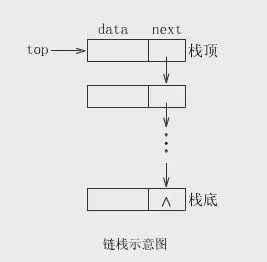1、栈的定义
栈是限制在一端进行插入操作和删除操作的线性表(俗称堆栈)
允许进行操作的一端称为“栈顶”
另一端称为“栈底”
当栈中没有元素时称为“空栈”
栈是一个特殊的线性表
特点:后进先出(LIFO)
2、顺序栈(sequence stack)
它是顺序表的一种,具有顺序表同样的存储结构,由数组定义,配合用数组下标表示的栈顶指针top(相对指针)完成各种操作
顺序栈的图示:

结构体如下所示:
struct Seqstack {
int *data;
int maxlen;
int top;
} stack;顺序栈的简单实现:
SeqStack.h
#include <iostream>
using namespace std;
struct Seqstack {
int *data;
int maxlen;
int top;
};
typedef Seqstack stack;
int stack_create(stack *S, int len);
int stack_push(stack *S, int data);
int stack_pop(stack *S);
int stack_print(stack *S);
int stack_top(stack *S);
int stack_free(stack *S);SeqStack.cpp
#include "SeqStack.h"
int stack_create(stack *S, int len)
{
S->data = new int[len];
S->top = -1;
S->maxlen = len;
cout << "stack S create success, S have " << len << " data." << endl;
return 0;
}
int stack_push(stack *S, int data)
{
if(S->top >= S->maxlen - 1 ) {
cout << "push error, stack full!" << endl;
return -1;
}
S->top ++;
S->data[S->top] = data;
return 0;
}
int stack_print(stack *S)
{
cout << "stack_print : ";
for (int i = 0; i <= S->top; i++) {
cout << S->data[i] << " ";
}
cout << endl;
return 0;
}
int stack_pop(stack *S)
{
if(S->top == -1) {
cout << "stack have no data, stack_pop failed!" << endl;
return -1;
}
S->top --;
return 0;
}
int stack_top(stack *S)
{
if(S->top == -1) {
cout << "stack_top have no data!" << endl;
return -1;
}
cout << "stack_top data : " << S->data[S->top] << endl;
return 0;
}
int stack_free(stack *S)
{
delete S->data;
S->maxlen = 0;
S->top = -1;
}
int main()
{
int tag = 0;
stack S;
tag = stack_create(&S, 6);
tag = stack_push(&S, 10);
tag = stack_push(&S, 20);
tag = stack_push(&S, 30);
tag = stack_print(&S);
tag = stack_pop(&S);
tag = stack_print(&S);
tag = stack_top(&S);
tag = stack_push(&S, 40);
tag = stack_push(&S, 50);
tag = stack_push(&S, 60);
tag = stack_push(&S, 70);
tag = stack_push(&S, 80);
tag = stack_top(&S);
tag = stack_print(&S);
tag = stack_free(&S);
}
// 执行结果
stack S create success, S have 6 data.
stack_print : 10 20 30
stack_print : 10 20
stack_top data : 20
push error, stack full!
stack_top data : 70
stack_print : 10 20 40 50 60 703、链栈(Linkstack)
插入操作和删除操作均在链表头部进行,链表尾部就是栈底,栈顶指针就是头指针。

结构体如下所示:
LinkStack.h
#include <iostream>
using namespace std;
typedef struct Node {
int data;
Node *next;
} Node;
typedef Node * Linkstack;
int stack_create(Linkstack *S);
int stack_push(Linkstack *S, int value);
int stack_pop(Linkstack *S);
int stack_top(Linkstack *S);
int stack_print(Linkstack *S);
int stack_free(Linkstack *S);LinkStack.cpp
#include "LinkStack.h"
int stack_create(Linkstack *S)
{
Node *head = new Node;
head->next = NULL;
*S = head;
cout << "stack_create S success." << endl;
return 0;
}
int stack_push(Linkstack *S, int value)
{
Node *node = new Node;
node->next = (*S)->next;
(*S)->next = node;
node->data = value;
return 0;
}
int stack_print(Linkstack *S)
{
Node *node = *S;
cout << "stack_print : ";
while (node->next != NULL) {
cout << node->next->data << " ";
node = node->next;
}
cout << endl;
return 0;
}
int stack_pop(Linkstack *S)
{
int top_data = (*S)->next->data;
Node *node = new Node;
node = (*S)->next;
(*S)->next = (*S)->next->next;
cout << "stack_pop " << top_data <<" success." << endl;
delete node;
return 0;
}
int stack_top(Linkstack *S)
{
cout << "stack_top data : " << (*S)->next->data << endl;
return 0;
}
int stack_free(Linkstack *S)
{
delete *S;
return 0;
}
int main()
{
Linkstack S;
stack_create(&S);
stack_push(&S, 10);
stack_push(&S, 20);
stack_push(&S, 30);
stack_print(&S);
stack_pop(&S);
stack_top(&S);
stack_print(&S);
stack_free(&S);
}
//执行结果
stack_create S success.
stack_print : 30 20 10
stack_pop 30 success.
stack_top data : 20
stack_print : 20 10





















 225
225











 被折叠的 条评论
为什么被折叠?
被折叠的 条评论
为什么被折叠?








